|
View as a webpage
|
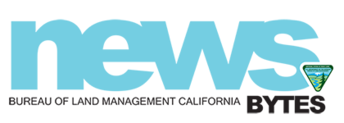
Lost Coast Headlands, part of the California Coastal National Monument
|
|
ISSUE 846 - March 28, 2019
|
|
|
- Track the Bloom
- Volunteers
- Headlines and Highlights
- BLM and DOI Highlights
- Wildlife Question of the Week
- Upcoming Events
|
|
Upcoming travel plans? Please remember to check road conditions and closures. Travelers can also download the QuickMap app, quickmap.dot.ca.gov, or call 1-800-427-7623 for constantly updated highway information. (California Department of Transportation)
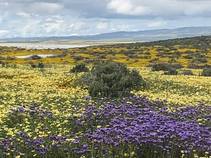
#TracktheBloom
This time of year there is a lot of #CAlove, especially with the much anticipated wildflowers. We will continue sharing updates from your public lands to help visitors know what to realistically expect when it comes to wildflower blooms. As you make plans to #RoadTripCalifornia, please remember the importance of Leave No Trace principles.
As of March 27, 2019, the wildflowers are stunning at Carrizo Plain National Monument with more blooming daily on the valley floor and mountain ranges. Gold fields, Tidy Tips and Phacilia continue to bloom.
REMINDER: Rain showers continue, please be cautious on dirt roads! Campgrounds fill up fast or are already full so plan accordingly. Don’t drive into the flowers, park alongside the road (parallel) as not to obstruct other traffic and watch for pedestrians. Please follow warning signs and respect private property when visiting your public lands. This is a remote area with limited towing services, no fuel, food or water nearby. Don’t forget to check the visitor center wildflower info line (805) 475-2035.
Related: Leave No Trace Center for Outdoor Ethics
Related: Theodore Payne Wild Flower Hotline
Related: Desert USA Wildflower Report
|

People Are Getting Their Cars Stuck in Mud Trying To Go See the Super Bloom Wildflowers
People in search of photos of the stunning wildflower super bloom found themselves in a much less Instagrammable situation this week when they got their cars stuck in mud on the plains of Central California. It's happened to at least four cars this week along various roads on the Carrizo Plains in San Luis Obispo County, the California Highway Patrol told the San Luis Obispo Tribune on Thursday. CHP helicopters were reportedly used to help locate the stranded travellers, and the CHP then helped enlist tow trucks to drag the cars to safety. Earlier this week, the Bureau of Land Management warned people that the roads in the area were treacherous and muddy because of recent rainfall. (SF Gate)
|
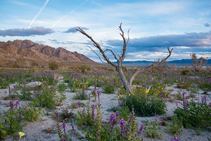
Yes, You Still Have Time To See the Super Bloom — If You Know Where To Go
Blazing fields of desert dandelions, streaks of purple lupine and pink sand verbena, and poppies bursting along hillsides have transformed Southern California. There’s still plenty of time to see this season’s outstanding bloom of annual wildflowers, if you know where to go... Chasing desert wildflowers, even in a big, wet year, can be daunting, because they don’t bloom everywhere and they don’t bloom at the same time. The other daunting factor? Mobs of people who crave that uniquely California touch of nature. In mid-March, I took off to find the best wildflower destinations, places expected to hang in there for the a few weeks. My quest fueled by hope, stamina and lots of gas covered 746 miles in 2½ days — and revealed spectacular and often unexpected wildflower blooms at Anza-Borrego Desert State Park, the southern end of Joshua Tree National Park, various spots in Mojave Trails National Monument and the incomparable hills surrounding Diamond Valley Lake near Hemet. (Los Angeles Times)
|
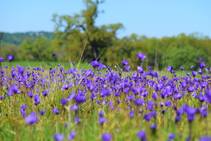
Remember to #LeaveNoTrace While You #TracktheBloom
The Bureau of Land Management in California is excited to #TracktheBloom this year! The always anticipated spring wildflower blooms, especially in the Golden State are making headlines and it's no surprise why. With these blooms come an increased need for our public lands visitors to help care for these stunning landscapes, practice responsible wildflower viewing and set realistic expectations for what Mother Nature has in store. (BLM California Facebook)
|
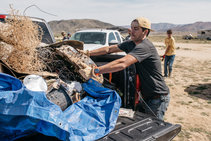
Off-Road Community Cleans-Up Public Lands
Decades worth of trash and debris were removed from BLM-managed public lands not far from Joshua Tree National Park earlier this month with the help of over 200 volunteers from the off-road community. Two dumpsters, 40 feet in length, were filled and removed from the site, along with several runs to the dump by a 12 foot flatbed trailer. Despite the robust efforts from volunteers, years worth of litter and debris remains scattered on public lands requiring additional resources and volunteer coordination. Plans are already in the works by these great volunteers for an additional trash removal weekend this fall. Stay tuned. (BLM California Facebook)
|
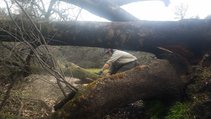
BLM and Volunteers Work on Trails Damaged by the Carr Fire
It's been a tough year for recreational trails managed by the BLM Redding Field Office, but crews have been up to the challenge of getting them ready for the busy spring season. Crews faced big jobs after the trails were damaged by last summer's Carr Fire, heavy winter rains and a record Valentine's Day snowfall in Redding. Local volunteers have joined our recreation and fire staffs and an AmeriCorps crew and dedicated themselves to the nearly nonstop work. They have cleared thousands of trees damaged by fire and snow, rebuilt trails and footbridges, repaired washouts and installed new signs across the 130-mile trail system designed for non-motorized recreation. Volunteers from the Redding Trail Alliance have been a big help in all this work. (BLM California Facebook)
|
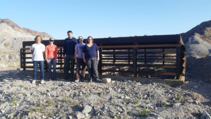
The BLM and California Department of Conservation Partner to Address Potentially Hazardous Abandoned Mine Openings
The Bureau of Land Management and California Department of Conservation, Division of Mine Reclamation, are working together to close 65 potentially hazardous abandoned mine openings to protect desert visitors who are riding off-road vehicles, mountain biking or hiking. The mines are in the Cargo Muchacho Mountains, southeast of the Salton Sea and east of the Imperial Sand Dunes, near the California border. The project is expected to be completed by early April. (BLM and California Department of Conservation news release)
|

Mother Shares Story About the Day Her Son and His Service Dog Spent with a BLM Ranger and K9
This is K9 Enzo and his partner Officer Carpenter with the Bureau of Land Management. K9 Enzo is a mostly black German Shepherd who is dual purpose trained in patrol and narcotics. Together this team works from Santa Fe New Mexico to the Colorado and Texas state lines. He and K9 Enzo have been partners for almost 3 years and nationwide they are 1 out of only 12 K9 teams for the BLM. This past weekend we spent the day at the U.S. Navy Blue Angels first air show of the season and of course one of Jackson’s favorite things to do is to check out the local law enforcement booths. We happened upon Officer Carpenter who is currently working in this area and Jackson was able to “coin him”. (BLM California Facebook)
|
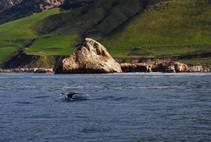
Gray Whales Are Swimming Up California’s Central Coast. Here’s How to See Them
Next time you’re on a coastal bluff, keep an eye out for a telltale puff of misty water in the ocean: It could be a gray whale surfacing to breathe. The whales are currently in the middle of their northbound migration up to the Bering Sea, and they’re beginning to be spotted in greater numbers along the Central Coast. PG&E meteorologist John Lindsey snapped some photos of a gray whale while he was operating a tour boat just north of the Diablo Canyon nuclear power plant on Tuesday. Moylan recommended Montaña de Oro, Point Buchon Trail and Piedras Blancas Light Station as good viewing points, though access to Point Buchon and Piedras Blancas is restricted to certain days. Lindsey also recommended Piedras Blancas and Windy Point on the Point Buchon Trail, as well as the Point San Luis Lighthouse. (The Tribune)
Related: Piedras Blancas Light Station, part of the California Coastal National Monument (BLM website)
|
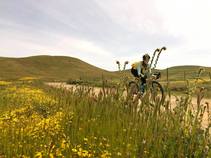
2019 Panoche Desert Hills MTB Race
The BLM Central Coast Field Office issued a special recreation permit for a cyclocross long-distance mountain bike race within the Panoche and Tumey Hills in eastern San Benito County and western Fresno County last weekend. Nearly 85 riders took in the views from public lands while on their bikes. There were three check stations along the 60-mile course with hot food, drinks and bike repair stations coordinated by Superpro Racing. (BLM California Facebook)
|

Goats! Goats! Goats!
The goats have been grazing at the Fort Ord National Monument since October 2018. Now that we have been getting lots of rain at the monument, the goats have a lot of work to do. Many of the visitors love seeing the goats hard at work removing fuels and lowering the level of fire danger. Some of those visitors have children that attend Toro Park School. Toro Park School has approximately 400 students attending transitional kindergarten through third grade. Every spring BLM brings all the students out to see the goats. (BLM California Facebook)
|
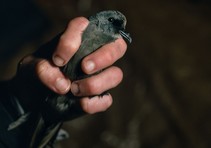
Cryptic Seabirds Can Hide From This Scientist, But Not From Her Spy Network
Acoustic monitoring combined with powerful machine learning is giving researchers new insights into the elusive Ashy Storm-Petrel. It's just one way that artificial intelligence can tackle pressing conservation challenges. (Audubon)
|
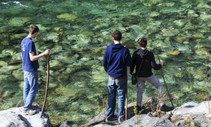
Acting Secretary Bernhardt Signs Order to Prioritize Implementation of Bipartisan Public Lands Bill
U.S. Acting Secretary of the Interior David Bernhardt signed a secretarial order to establish a Departmental task force to facilitate and prioritize the implementation of S. 47, the John D. Dingell, Jr. Conservation, Management, and Recreation Act. The bill was made up of more than 100 individual bills that were introduced by 50 Senators and several House members. The Interior Department had advocated for in concept or worked with Members of Congress on many of the individual provisions that made up the package. (DOI news release)
|

Acting Secretary Bernhardt Signs Order to Ensure Public Access is Considered in Land Transactions
Acting Secretary of the Interior David Bernhardt signed a secretarial order directing that the Bureau of Land Management adequately weigh public access for outdoor recreation – including hunting and fishing – when determining the appropriateness of the disposal or exchange of public lands. Identifying lands as available for disposal or exchange is required under federal law. The Federal Land Policy and Management Act of 1976 directs the BLM to identify lands for potential disposal or exchange, using a public process and with state and county involvement. BLM has carried out these provisions revising land use plans and disposal since 1976. However, the BLM’s criteria do not require the agency to weigh public access considerations for outdoor recreation (fishing, hunting, hiking, etc.). (DOI news release)
|
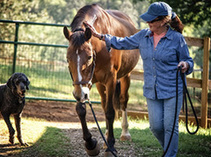
Bureau of Land Management Offers New Incentives to Encourage More Adoptions of Wild Horses and Burros
As part of the Bureau of Land Management’s effort to find good homes for wild horses and burros removed from public lands, the agency today began offering new financial incentives to encourage qualified people to adopt one or more of the animals. The program is part of the BLM’s efforts to confront a growing over-population of wild horses and burros on fragile rangelands and in off-range holding facilities, which cost taxpayers nearly $50 million every year to maintain. (BLM news release)
Related: BLM wild horse and burro adoption stories (My Public Lands Flickr)
Related: The federal government is offering $1,000 if you adopt a wild horse (Mashable)
|

How to Safely Hike, Camp, and Backpack With Your Dog
Dogs can be excellent company in the outdoors. Exploring the wilderness with a furry friend can be an incredibly fun and bonding experience, but only if you plan ahead. If you don’t, bringing your dog could be a dangerous mistake, one that ends abruptly, unpleasantly, or even tragically. (Backpacker Magazine)
|
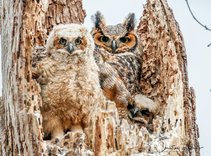
True or False
Great horned owls “horns” are actually feathers and have nothing to do with hearing.
Keep scrolling to find out!
|
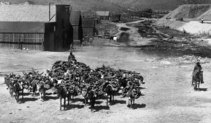
Now - December 2019: Fueling the Boom, Chinese Woodcutters in the Great Basin 1870-1920
The Nevada State Museum in Carson City is hosting a new exhibit featuring historical/ archaeological artifacts and photographs about Chinese woodcutting camps from Bodie Hills. The exhibit will highlight the significance of the woodcutting community near Chinese Camp (Aurora), shedding light on the little-known history of the Chinese woodcutters who lived there and felled pinyon pines to supply charcoal and firewood to the mining camps of Bodie and Aurora from 1875 to 1915. (Nevada State Museum website)
|
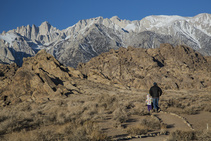
The Bureau of Land Management Bishop Field Office, Alabama Hills Stewardship Group and Eastern Sierra Interpretive Association will be hosting two-hour, guided hikes about the film, geology and natural history of the Alabama Hills. Hikes will begin at 10 a.m. and leave from the Eastern Sierra Interagency Visitor Center at the intersection of U.S. Route 395 and California State Route 136 in Lone Pine. (BLM news release)
|

April 1 to May 31: 3rd Annual Redding Mayor's Mountain Bike Challenge
The 3rd annual Mayor's Mountain Bike Challenge is back to highlight backcountry and year-round single track trails near the City of Redding including BLM-managed public lands. This event was inspired by riders for riders. Visit Redding loves trails and wanted to get more people, locals and visitors alike, to fall in love with them. The Mayor's Mountain Bike Challenge is free to participate in and helps people discover some of the most exciting and challenging routes the North State has to offer. For more information, go to MayorsMTBChallenge.org.
|

April 6: Johnson Valley Shared Use Area Resource Management Group Meeting
Representatives from the Bureau of Land Management Barstow Field Office and the Marine Corps Air Ground Combat Center at Twentynine Palms will host a Resource Management Group meeting from 10 to 11 a.m., April 6, at the Yucca Room at the Yucca Valley Community Center, 57090 Twentynine Palms Highway, Yucca Valley. The meeting is open to the public. Representatives will be available to answer questions and discuss the Shared Use Area of the Johnson Valley Off-Highway Vehicle Recreation Area. (BLM news release)
|
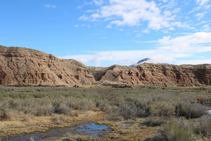
April 6 and 7: Desert Willow Restoration Project in Afton Canyon
Volunteers are needed for a tree planting event in Mojave Trails National Monument's Afton Canyon. Afton Canyon's breathtaking geology and iconic scenic beauty, combined with rare desert riparian habitat, is not to be missed! The area has been the focus of several wildlife habitat enhancement efforts over the last several years such as tamarisk removal, natural habitat planting and barrier fencing. This project is the next phase in eliminating invasive species and replacing them with native trees. Volunteers will be planting trees in a riparian area, with holes previous drilled by the BLM. The tree planting takes place over April 6 and 7 - you can attend for one day or both! (Mojave Desert Land Trust Facebook)
|
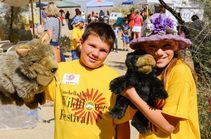
April 7 and May 5: Story Time and Young Explorers at Santa Rosa and San Jacinto Mountains National Monument
Story Hour for children ages 5 to 7: Join us in our Kid’s Corner to hear a story about nature and creatures that live in the desert of the Santa Rosa and San Jacinto Mountains National Monument. Reading will be followed by an indoor or outdoor arts and crafts activity.
Young Explorers for ages 8 and above: Compass and maps are a very important part of your 10 essentials when hiking in the desert. Let’s explore and have fun learning about them!
RSVP required. Event will take place from 1 to 2 p.m. Please visit www.desertmountains.org/calendar or call (760) 862-9984 for more information.
|
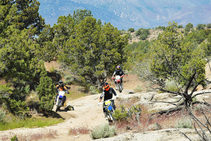
April 13 and 14: Motorcycle Races Coming for Fort Sage Area; Some Trail Access Will Be Limited
Up to 200 riders are expected to participate in the Diamond Back Hare Scrambles motorcycle race, Saturday and Sunday, April 13 and 14, at the Fort Sage Off-Highway Vehicle Area near Doyle. Trail access will be available only to participants while the races are underway.
Spectators are welcome at designated viewing areas at the Widow Maker, Land of David and Raptor trailheads. Participants and visitors can camp overnight at the main Fort Sage Trailhead. Single-day visitors will use parking areas along access roads. (BLM news release)
|
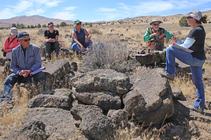
August 2-4: 2nd Annual Wild Horse Walkabout
Save the date! The public is invited to the Twin Peaks Herd Management Area near Susanville, CA. Attendees will spend the two nights out on the range to learn about how the BLM monitors rangeland and herd health from a BLM wild horse and burro specialist. Don't miss this unique opportunity to learn more about how BLM manages wild horses and burros. (BLM California Facebook)
|
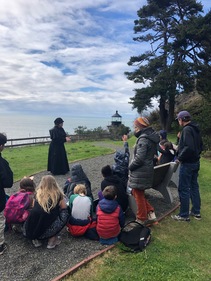
First Saturday of Every Month: Living History at Trinidad Head Lighthouse
BLM Park Ranger Julie Clark plays Josephine Harrington for Trinidad School students at Trinidad Head Lighthouse. Josephine lived with her husband, Captain Fred Harrington the lighthouse keeper, at the Trinidad Head Lighthouse for 28 years. Julie has been performing this living history piece to bring the past to life since the BLM acquired the lighthouse in 2014. Now part of the California Coastal National Monument, the Trinidad Head Lighthouse is open to the public the first Saturday of every month (year-round). Visitors can climb to the top of the lighthouse from 10 a.m. to 12 p.m. thanks to docents from the Trinidad Museum Society.
Contact the Arcata Field Office for details, (707) 825-2300.
|
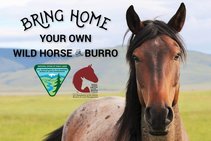
Ongoing: Bring Home a Wild Horse or Burro
The BLM Wild Horse and Burro Program is excited to announce nearly 70 events this year as part of BLM's efforts to find good homes for our nation's wild horses and burros. Known for their intelligence, endurance and loyalty, wild horses and burros, with the right training, are outstanding for trail riding, packing, working and have successfully competed for awards in numerous fields from endurance riding to dressage. With more than 81,000 wild horses and burros on BLM-managed public lands, these wild icons of our American history need your help more than ever. Without any natural predators that can control population growth, wild horse and burro herds grow rapidly on the range and can quickly overcome the land's ability to support them. The BLM works to maintain healthy wild herds by gathering excess animals and placing them into good homes. (BLM website)
|
|
WILDLIFE QUESTION OF THE WEEK ANSWER
True.
The great horned owl is native to the Americas, and is one of the areas most widespread owl species. Its diet consists of mammals such as mice, voles, weasels, rabbits, squirrels and rats, but will often take larger prey including skunks and other owls. Like most owls, the great horned owl hunts at night, utilizing good eyesight and excellent hearing. Once its prey has been located it will silently swoop onto the animal, using its sharp talons to quickly grasp and kill it. Great horned owls have many different calls. They bark, rattle, growl, shriek, whoop and hoot. Their ear tufts, or horns, have nothing to do with hearing. It is thought that the tufts are a form of camouflage in that it changes the shape of the bird as it sits in a tree. It is thought that the tufts appear to be a part of a splintered tree branch. (Willapa National Wildlife Refuge website)
|
|
|
News.Bytes is a publication of the Bureau of Land Management in California.
Bureau of Land Management
California State Office
2800 Cottage Way, Suite W1623
Sacramento, CA 95825
(916) 978-4600
Send comments to the News.Bytes Team | Subscribe to News.Bytes | Unsubscribe
|
     
|
|
|